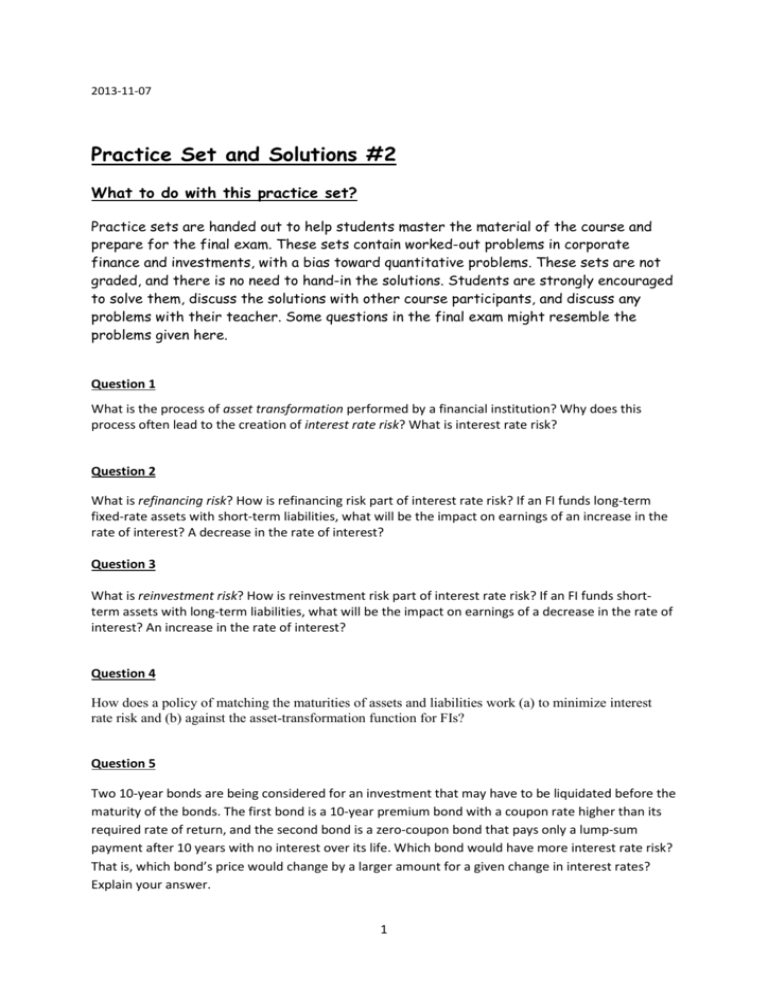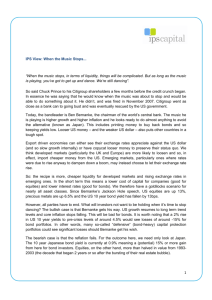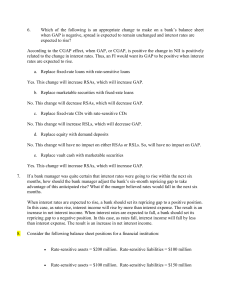Practice Set and Solutions #2
advertisement

2013-11-07 Practice Set and Solutions #2 What to do with this practice set? Practice sets are handed out to help students master the material of the course and prepare for the final exam. These sets contain worked-out problems in corporate finance and investments, with a bias toward quantitative problems. These sets are not graded, and there is no need to hand-in the solutions. Students are strongly encouraged to solve them, discuss the solutions with other course participants, and discuss any problems with their teacher. Some questions in the final exam might resemble the problems given here. Question 1 What is the process of asset transformation performed by a financial institution? Why does this process often lead to the creation of interest rate risk? What is interest rate risk? Question 2 What is refinancing risk? How is refinancing risk part of interest rate risk? If an FI funds long-term fixed-rate assets with short-term liabilities, what will be the impact on earnings of an increase in the rate of interest? A decrease in the rate of interest? Question 3 What is reinvestment risk? How is reinvestment risk part of interest rate risk? If an FI funds shortterm assets with long-term liabilities, what will be the impact on earnings of a decrease in the rate of interest? An increase in the rate of interest? Question 4 How does a policy of matching the maturities of assets and liabilities work (a) to minimize interest rate risk and (b) against the asset-transformation function for FIs? Question 5 Two 10-year bonds are being considered for an investment that may have to be liquidated before the maturity of the bonds. The first bond is a 10-year premium bond with a coupon rate higher than its required rate of return, and the second bond is a zero-coupon bond that pays only a lump-sum payment after 10 years with no interest over its life. Which bond would have more interest rate risk? That is, which bond’s price would change by a larger amount for a given change in interest rates? Explain your answer. 1 Question 6 What is market risk? How does this risk affect the operating performance of financial institutions? Question 7 What is credit risk? Question 8 What is the nature of an off-balance-sheet activity? How does an FI benefit from such activities? Identify the various risks that these activities generate for an FI, and explain how these risks can create varying degrees of financial stress for the FI at a later time. Question 9 What is country or sovereign risk? What remedy does an FI realistically have in the event of a collapsing country or currency? Question 10 What is liquidity risk? What routine operating factors allow FIs to deal with this risk in times of normal economic activity? What market reality can create severe financial difficulty for an FI in times of extreme liquidity crises? Question 11 Why can insolvency risk be classified as a consequence or outcome of any or all of the other types of risks? Question 12 What is the repricing gap? In using this model to evaluate interest rate risk, what is meant by rate sensitivity? On what financial performance variable does the repricing model focus? Explain. Question 13 8. Consider the following balance sheet positions for a financial institution: Rate-sensitive assets = $200 million. Rate-sensitive liabilities = $100 million Rate-sensitive assets = $100 million. Rate-sensitive liabilities = $150 million Rate-sensitive assets = $150 million. Rate-sensitive liabilities = $140 million a. Calculate the repricing gap and the impact on net interest income of a 1 percent increase in interest rates for each position. 2 b. Calculate the impact on net interest income on each of the above situations assuming a 1 percent decrease in interest rates. c. What conclusion can you draw about the repricing model from these results? Question 14 What are some of the weakness of the repricing model? Question 15 The current one-year Treasury bill rate (1r1) is 5.2 percent, and the implicit forward one-year rate 1f2 12 months from now is 5.8 percent. According to the unbiased expectations theory, what should be the current rate (1r2 ) for a two-year Treasury security? Question 16 The Wall Street Journal reported interest rates of 6 percent, 6.35 percent, 6.65 percent, and 6.75 percent for three-year, four-year, five-year, and six-year Treasury notes, respectively. According to the unbiased expectations theory, what are the expected one-year rates for years 4, 5, and 6? Question 17 You note the following yield curve in The Wall Street Journal. According to the unbiased expectations hypothesis, what is the implicit one-year forward rate for the period beginning two years from today, 2f1? Maturity Yield One day 2% One year 5.5% Two years 6.5 Three years 9 Question 18 a) If both buyers (the public) and sellers of bonds (business) thinks that inflation will go up how will that change the demand for bonds, interest rates and the slope of the yield curve. 3 b) If investors (demand for bonds) think that bad times are coming how will that change the demand for bonds, interest rates and slope the yield curve? Question 19 How does the liquidity premium theory of the term structure of interest rates differ from the unbiased expectations theory? In a normal economic environment, that is, an upward- sloping yield curve, what is the relationship of liquidity premiums for successive years into the future? Why? Question 20 Based on economists’ forecasts and analysis, the one-year Treasury bill rates and liquidity premiums for the next four years are expected to be as follows: 1R1 = 5.65% E(2r1) = 6.75% L2 = 0.05% E(3r1) = 6.85% L3 = 0.10% E(4r1) = 7.15% L4 = 0.12% Make use the liquidity premium hypothesis and plot the yield curve. (Make sure you label the axes on the graph and identify the four annual rates on the curve both on the axes and on the yield curve itself.) What is the slope and how does the interpretation change compared with the expectations theory? Question 21 Quote from The Times Thursday Nov 8, 2011 (Ian King: Business Editor’s Commentary “Tensions were running high in the eurozone sovereign debt markets first thing. Italian ten-year bond yields had burst through the 7 per cent barrier on Wednesday and looked set for another choppy session, with the spread between Italian BTPs and German bunds withering. However, between 6.53 am and 8.28 am London time, the yield on Italian ten years fell from 7.003 per cent to 6.816 per cent. The spread with bunds contracted sharply. This was a big move and ascribed to aggressive buying the European Central Bank. The ECB’s buying mainly of two-year paper, was itself critical because yields on two-year debt had, the day before, traded at higher yields than the ten year debt. “ “Happily, the ECB’s intervention did the trick, creating a calmer atmosphere in which Italy could auction €5 billion worth of one-year Treasury bills – a sale that had been advertised in advance as critical test of demand for Italian debt. The sale passed successfully, although Italy had to pay 6.087 per cent for its money, a 14-year record. Traders say that it is not unusual for the ECB to intervene in this way on days when vulnerable eurozone countries are auctioning their debt” 4 (Bunds are German state bond issued with maturities up to 30 years) a) What is the implication of two-year bonds trading at higher yields than ten-year bonds? b) To achieve the effect on two-year bonds mentioned above, did the ECB buy or sell Italian bonds? c) Why didn’t the Italian government sell ten year bonds instead of one-year bonds? SOLUTIONS Solution 1 Asset transformation by an FI involves purchasing primary assets and issuing secondary assets as a source of funds. The primary securities purchased by the FI often have maturity and liquidity characteristics that are different from the secondary securities issued by the FI. For example, a bank buys medium- to long-term bonds and makes medium-term loans with funds raised by issuing shortterm deposits. Interest rate risk occurs because the prices and reinvestment income characteristics of long-term assets react differently to changes in market interest rates than the prices and interest expense characteristics of short-term deposits. Interest rate risk is the risk incurred by an FI when the maturities of its assets and liabilities are mismatched. Solution 2 See Textbook. Solution 3 See Textbook. Solution 4 A policy of maturity matching will allow changes in market interest rates to have approximately the same effect on both interest income and interest expense. An increase in rates will tend to increase both income and expense, and a decrease in rates will tend to decrease both income and expense. The changes in income and expense may not be equal because of different cash flow characteristics of the assets and liabilities. The asset-transformation function of an FI involves investing short-term liabilities in long-term assets. Maturity matching clearly works against successful implementation of this process. Solution 5 5 The zero-coupon bond would have more interest rate risk. Because the entire cash flow is not received until the bond matures, the entire cash flow is exposed to interest rate changes over the entire life of the bond. The cash flows of the coupon-paying bond are returned with periodic regularity, thus allowing less exposure to interest rate changes. In effect, some of the cash flows may be received before interest rates change. Solution 6 & 7 See Textbook. Solution 8 Off-balance-sheet activities are contingent commitments to undertake future on-balance-sheet investments. The usual benefit of committing to a future activity is the generation of immediate fee income without the normal recognition of the activity on the balance sheet. As such, these contingent investments may be exposed to credit risk (if there is some default risk probability), interest rate risk (if there is some price and/or interest rate sensitivity), and foreign exchange rate risk (if there is a cross currency commitment). Solution 9-11 See Textbook. Solution 12 The repricing gap is a measure of the difference between the dollar value of assets that will reprice and the dollar value of liabilities that will reprice within a specific time period, where repricing can be the result of a roll over of an asset or liability (e.g., a loan is paid off at or prior to maturity and the funds are used to issue a new loan at current market rates) or because the asset or liability is a variable rate instrument (e.g., a variable rate mortgage whose interest rate is reset every quarter based on movements in a prime rate). Rate sensitivity represents the time interval where repricing can occur. The model focuses on the potential changes in the net interest income variable. In effect, if interest rates change, interest income and interest expense will change as the various assets and liabilities are repriced, that is, receive new interest rates. Solution 13 a) Rate-sensitive assets = $200 million. Rate-sensitive liabilities = $100 million. Repricing gap = RSA - RSL = $200 - $100 million = +$100 million. ∆NII = ($100 million)(.01) = +$1.0 million, or $1,000,000. Rate-sensitive assets = $100 million. Rate-sensitive liabilities = $150 million. Repricing gap = RSA - RSL = $100 - $150 million = -$50 million. 6 ∆NII = (-$50 million)(.01) = -$0.5 million, or -$500,000. Rate-sensitive assets = $150 million. Rate-sensitive liabilities = $140 million. b) Solution 13 b ∆NII = ($100 million)(-.01) = -$1.0 million, or -$1,000,000. ∆NII = (-$50 million)(-.01) = +$0.5 million, or $500,000. ∆NII = ($10 million)(-.01) = -$0.1 million, or -$100,000. c) The FIs in parts (1) and (3) are exposed to interest rate declines (positive repricing gap), while the FI in part (2) is exposed to interest rate increases. The FI in part (3) has the lowest interest rate risk exposure since the absolute value of the repricing gap is the lowest, while the opposite is true for the FI in part (1). Solution 14 See Textbook. Solution 15 (1.052)(1.058) = (1 + 1r2)2 = 1.113016; (1 + 1r2) = 1.054996 ⇒ 1r2 = .0550 or 5.50 percent Solution 16 [1 + E(ir1)] = (1 + 1Ri)i ÷ (1 + 1Ri-1)i-1 [1 + E(4r1)] = (1.0635)4 ÷ (1.06)3 = 1.0741 ⇒ E(4r1) = 7.41 percent for period 4 [1 + E(5r1)] = (1.0665)5 ÷ (1.0635)4 = 1.0786 ⇒ E(5r1) = 7.86 percent for period 5 [1 + E(6r1)] = (1.0675)6 ÷ (1.0665)5 = 1.0725 ⇒ E(6r1) = 7.25 percent for period 6 Solution 17 The implicit forward rates are f2 = [(1 + 1r2)2/(1 + 1r1)] – 1 f2 = [(1.065)2/(1.055)] - 1 = 7.51% 7 Solution 18 a) If inflation is going up existing bonds, with given nominal values and coupons, do not offer a yield that compensates for inflation (r = real rate + expected inflation). Thus, demand is lowered and prices of bonds fall until they offer the required yield. In addition, if prices are expected to go up it makes sense to consume today (incl. buying capital goods) before prices increase. For business today’s bonds have a low real yield, why it is profitable to increase the supply of bonds and invest more. They will increase the supply of long term bonds and drive prices down. The outcome is a shift up in the yield curve, as the yield adjusts to higher inflation expectations. We can make a case for a steeper slope, in particular if expected inflation is associated with a boom in the economy. b) Coming bad times means that you have to save more for the bad times going. Cut down on current consumption and buy bonds that mature when the bad times are coming. Say that you expect bad times 18 months from now, then you buy bonds with a maturity, which in turn drives up the price of these bonds and brings down the yield. You could see the yield curve becoming humped shaped with lower mid –term bonds selling at higher prices than long-term bonds. Solution 19 See text book and Lecture notes. Solution 20 1r 1 = 5.65% 1r 2 = [(1 + .0565)(1 + .0675 + .0005)]½ - 1= 6.22% 1r 3 = [(1 + .0565)(1+.0675 + .0005)(1 + .0685 + .001)]1/3- 1 = 6.47% 1r 4 = [(1 + .0565)(1 + .0675 + .0005)(1+.0685 + .001)(1 + .0715 + .0012)]1/4- 1 = 6.67% and the current yield curve will be upward sloping as shown: YTM 6.67% 6.47% 6.22% 5.65% _____________________________ Term to Maturity 0 1 2 3 4 (in years) 8 Solution 21 a) Usually this type of yield curve predicts a recession. (Explain why) b) If ECB sell bonds prices goes down and the yield goes up. (see the valuation formula to understand the link between prices and yields) You can use a supple a demand diagram such as the one in Figure 3 in my memo to show how things works. 9











